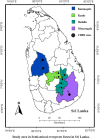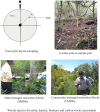Impact of community-based forest restoration on stand structural attributes, aboveground biomass and carbon stock compared to state-managed forests in tropical ecosystems of Sri Lanka
- PMID: 39346074
- PMCID: PMC11439398
- DOI: 10.7717/peerj.18176
Impact of community-based forest restoration on stand structural attributes, aboveground biomass and carbon stock compared to state-managed forests in tropical ecosystems of Sri Lanka
Abstract
Estimation of plant community composition, aboveground biomass and carbon stock is crucial for understanding forest ecology, strengthening environmental management, and developing effective tools and policies for forest restoration. This study was conducted in nine different forest reserves in Sri Lanka from 2012 to 2018 to examine the impact of community-based forest restoration (CBFR) on stand structural attributes, aboveground biomass, and carbon stock compared to state-managed forests. In total, 180 plots (90 plots in community-managed restoration blocks (CMRBs) and 90 plots assigned to state-managed restoration blocks (SMRBs)) were sampled at the study site. To conduct an inventory of standing trees, circular plots with a radius of 12.6 m (equivalent to an area of 500 square meters) were established. The Shannon diversity index, Allometric equations and Difference in Differences (DID) estimation were used to assess the data. Our study provides evidence of the positive impact of the CBFR program on enriching trees diversity. Considering stand structural attributes of both blocks showed higher trees density in the smaller diameter at breast height (DBH) category, indicating growth in both CMRBs and SMRBs. The results showed that tree biomass and carbon density were disproportionally distributed across the nine different forest reserves. On average, tree biomass and carbon density were higher in SMRBs (79.97 Mg ha-1, 37.58 Mg C ha-1) compared to CMRBs (33.51 Mg ha-1, 15.74 Mg C ha-1). However, CMRBs in Madigala reserve represent the highest biomass (56.53 and 59.92 Mg ha-1) and carbon density (26.57 and 28.16 Mg C ha-1). The results of biomass and carbon estimates were higher in all SMRBs in the nine different forest reserves compared to CMRBs. The findings suggest that future forest restoration programs in Sri Lanka should enhance participatory approaches to optimize tree species diversity, density and carbon storage, particularly in community-controlled forests. Our findings could assist developing tropical nations in understanding how CBFR impacts forest restoration objectives and improves the provision of ecological services within forests.
Keywords: Biomass; Carbon stock; Community-based forest restoration; DID model; Woody species diversity and density.
© 2024 Ahmad et al.
Conflict of interest statement
The authors declare that they have no competing interests.
Figures







Similar articles
-
Large-scale carbon stock assessment of woody vegetation in tropical dry deciduous forest of Sathanur reserve forest, Eastern Ghats, India.Environ Monit Assess. 2017 Apr;189(4):187. doi: 10.1007/s10661-017-5899-1. Epub 2017 Mar 28. Environ Monit Assess. 2017. PMID: 28353204
-
Tree diversity, population structure, biomass accumulation, and carbon stock dynamics in tropical dry deciduous forests of Eastern India.BMC Ecol Evol. 2025 May 16;25(1):48. doi: 10.1186/s12862-025-02385-9. BMC Ecol Evol. 2025. PMID: 40380124 Free PMC article.
-
Tree Diversity Enhances Stand Carbon Storage but Not Leaf Area in a Subtropical Forest.PLoS One. 2016 Dec 9;11(12):e0167771. doi: 10.1371/journal.pone.0167771. eCollection 2016. PLoS One. 2016. PMID: 27936198 Free PMC article.
-
Defaunation impacts on the carbon balance of tropical forests.Conserv Biol. 2025 Feb;39(1):e14414. doi: 10.1111/cobi.14414. Epub 2024 Oct 28. Conserv Biol. 2025. PMID: 39466005 Review.
-
Release of tree species diversity follows loss of elephants .from evergreen tropical forests.Proc Biol Sci. 2025 Apr;292(2044):20242026. doi: 10.1098/rspb.2024.2026. Epub 2025 Apr 2. Proc Biol Sci. 2025. PMID: 40169019 Free PMC article. Review.
References
-
- Acharya K. Conserving biodiversity and improving livelihoods: the case of community forestry in Nepal. International Conference on Rural Livelihoods, Forests and Biodiversity; 2003. pp. 19–23.
-
- Agrawal A, Cashore B, Hardin R, Shepherd G, Benson C, Miller D. New York: United Nations; 2013. Economic contributions of forests. Background Paper 1. (accessed 4 August 2023)
-
- Anup K. Global Exposition of Wildlife Management. London: InTech; 2017. Community forestry management and its role in biodiversity conservation in Nepal.
-
- Bandaratillake H, Durst P, Bishop A. Use of non-wood forest products by village communities in Sri Lanka. 1995. https://openknowledge.fao.org/server/api/core/bitstreams/b8fb5393-5478-4.... https://openknowledge.fao.org/server/api/core/bitstreams/b8fb5393-5478-4... (accessed 6 August 2023)
-
- Basnet S, Sharma P, Timalsina N, Khaine I. Community based management for forest conservation and livelihood improvement: a comparative analysis from forests in Myanmar. Journal of Forest and Livelihood. 2018;17(1):16–33.
Publication types
MeSH terms
Substances
LinkOut - more resources
Full Text Sources
Research Materials
Miscellaneous

